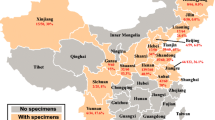Abstract
Recently, the domestic cat has been implicated in numerous outbreaks of Q fever in humans. To determine if cats in southern Africa are infected with the agent of Q fever we tested sera from cats in South Africa and Zimbabwe by indirect fluorescence for antibodies reactive with phase II Coxiella burnetii antigen (Nine Mile strain). Reactive antibodies were detected at titres of ≤ 1/40 in sera from cats in South Africa (1/52, 2%) and Zimbabwe (15/119, 13%). Our results indicate that cats in southern Africa are infected with C. burnetii and should be considered as sources of infection for humans.
Similar content being viewed by others
References
Kelly PJ, Matthewman LA, Mason PR, Raoult D. Q fever in Zimbabwe: A review of the disease and the results of a serosurvey of humans, cattle, goats and dogs. S Afr Med J 1993; 83: 21–25.
Gear JHS, Wolstenholme B. Q fever: Serological evidence of the occurrence of a case in South Africa. S Afr Med J 1950; 24: 409–411.
Saner RG, Fehler BM. A case of Q fever contracted on the Witwatersrand. S Afr Med J 1950; 24: 1000–1002.
Ranking DL. Q fever. Serological evidence of the occurrence of another case in South Africa. S Afr Med J 1950; 24: 1006–1008.
Gear J. The rickettsial diseases of Southern Africa. S Afr J Clin Sc 1954; 5: 158–175.
Marrie TJ, Durant H, Williams JC, Mintz E, Waag DM. Exposure to parturient cats: A risk factor for acquisition of Q fever in Maritime Canada. J Infect Dis 1985; 458: 101–108.
Gillespie JH, Baker JA. Experimental Q fever in cats. Am J Vet Res 1952; 13: 91–94.
Babudieri B. Q fever: A zoonosis. Adv Vet Sci 1959; 5: 81–181.
Abinanti FR, Lennette LH, Winn JF, Welsh HH. Q fever studies, XVIII: Presence of Coxiella burnetii in the birth fluid of naturally infected sheep. Am J Hyg 1953; 58: 385–388.
Higgins D, Marrie TJ. Seroepidemiology of Q fever among cats in New Brunswick and Prince Edward Island. Ann NY Acad Sci 1990; 590: 271–274.
Marrie TJ, MacDonald A, Durant H, Yates L, McCormick L. An outbreak of Q fever probably due to contact with a parturient cat. Chest 1988; 93: 98–103.
Marrie T, Langille D, Papukna V, Yates L. Truckin' pneumonia: An outbreak of Q fever in a truck repair plant probably due to aerosols contaminated by contact with newborn kittens. Epidemiol Infect 1989; 102: 119–127.
Langley JM, Marrie TJ, Covert A, Waag DM, Williams JC. Poker players' pneumonia: An urban outbreak of Q fever following exposure to a parturient cat. N Eng J Med 1988; 319: 354–356.
Gummow B, Poerstamper N, Herr S. The incidence of Coxiella burnetii antibodies in cattle in the Transvaal. Onderstepoort J Vet Res 1987; 54: 569–571.
Marrie TJ, Van Buren J, Faulkner RS, Haldane EV, Williams JC. Seroepidemiology of Q fever in Nova Scotia and Prince Edward Island. Can J Microbiol 1984; 30: 129–134.
Author information
Authors and Affiliations
Rights and permissions
About this article
Cite this article
Matthewman, L., Kelly, P., Hayter, D. et al. Exposure of cats in southern Africa to Coxiella burnetii, the agent of Q fever. Eur J Epidemiol 13, 477–479 (1997). https://doi.org/10.1023/A:1007317032647
Issue Date:
DOI: https://doi.org/10.1023/A:1007317032647




